Archived Fire Damage Blog Posts
Why smoke detectors are essential for home safety
12/11/2024 (Permalink)
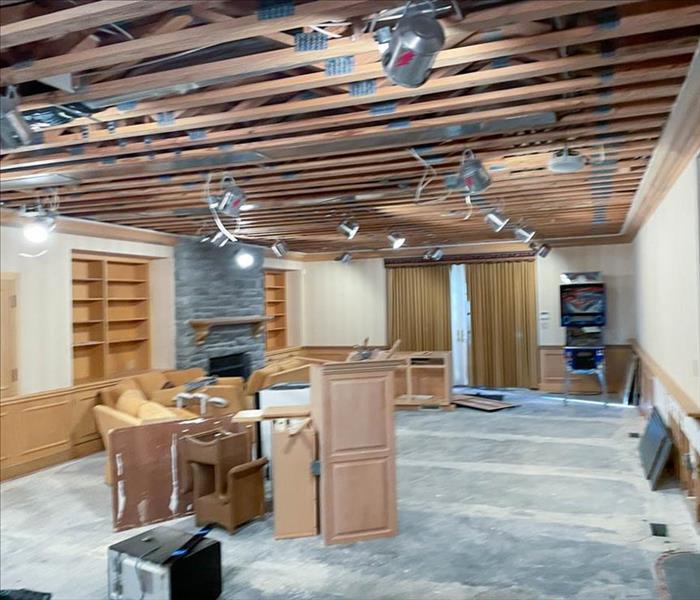 Smoke detectors are a simple, inexpensive, yet essential tool in protecting your home and family.
Smoke detectors are a simple, inexpensive, yet essential tool in protecting your home and family.
Smoke detectors are one of the most crucial safety devices you can have in your home. They provide an early warning system that helps prevent fire-related disasters, saving lives and property. In this blog, we’ll discuss why smoke detectors are essential for home safety, provide expert insights, and share a key statistic to highlight their importance.
Early Detection Saves Lives
One of the primary benefits of smoke detectors is their ability to detect fires at their earliest stages. According to the National Fire Protection Association (NFPA), three out of five home fire deaths occur in properties without working smoke alarms. Having a properly installed and functioning smoke detector gives homeowners those precious extra minutes to evacuate or address a small fire before it grows out of control.
Smoke Detectors Are Cost-Effective Safety Tools
Smoke detectors are affordable and easy to install, making them one of the best investments for your home’s safety. Basic models are available for less than $20, while more advanced ones, with features like interconnectivity and carbon monoxide detection, still remain within an affordable price range. These devices require little maintenance—just a simple battery check twice a year and replacement every 10 years. The small cost of maintaining your smoke detectors is far outweighed by the peace of mind they provide.
The Role of Interconnected Smoke Detectors
For enhanced home safety, interconnected smoke detectors are highly recommended. When one smoke detector is triggered, all the alarms in your home sound off simultaneously, ensuring that everyone is alerted, no matter where they are in the house. This feature is particularly useful in larger homes or multi-story residences.
Tips for Proper Smoke Detector Placement
For maximum effectiveness, consider the following when installing smoke detectors:
- Install a smoke detector on every level of your home.
- Place detectors inside each bedroom and outside sleeping areas.
- Ensure detectors are at least 10 feet away from the kitchen to reduce false alarms.
- Avoid placing detectors near windows or air vents, as drafts can interfere with their operation.
Regular Maintenance Is Key
Like all devices, smoke detectors require maintenance. Test your smoke detectors at least once a month to ensure they are functioning properly. Replace batteries at least once a year, or as soon as the low battery warning chirps. Following these basic maintenance tips will help ensure your smoke detectors work when you need them the most.
Smoke detectors are a simple, inexpensive, yet essential tool in protecting your home and family. By installing them throughout your home and regularly maintaining them, you significantly reduce the risk of fire damage and increase your safety. Remember, at SERVPRO of Clayton/Ladue, we’re available to help you recover from fire damage and ensure your home is as safe as possible.
Protect Your Loved Ones: How to Create a Fire Safety Plan for Your Family
8/14/2024 (Permalink)
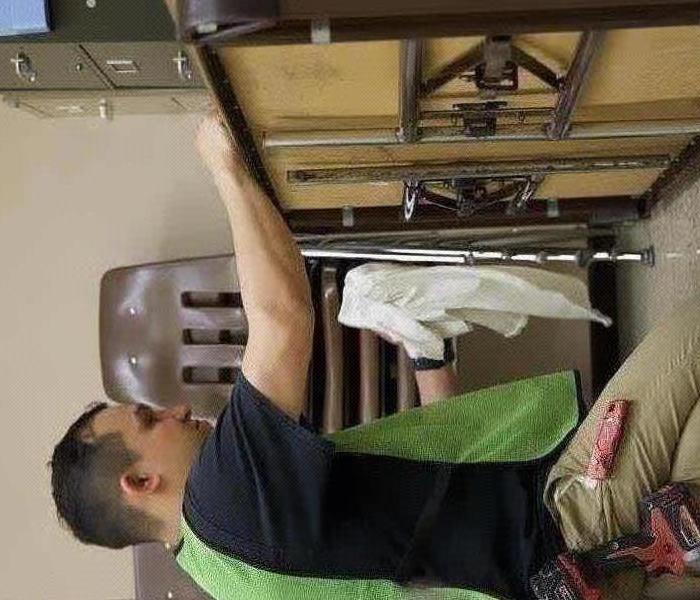 Follow this guide to create an effective fire safety plan for your family.
Follow this guide to create an effective fire safety plan for your family.
When it comes to protecting your family, having a well-prepared fire safety plan is crucial. In St. Louis, MO, where historic homes and modern residences intertwine, it's essential to be proactive in safeguarding your loved ones from the potential dangers of a fire. Follow this guide to create an effective fire safety plan for your family.
Understanding the Importance of a Fire Safety Plan
A fire safety plan is not just a checklist; it is a comprehensive strategy to ensure that everyone in your household knows what to do in case of a fire. This plan can be the difference between safety and tragedy. By preparing in advance, you give your family the best chance of escaping a fire unharmed.
Steps to Create Your Fire Safety Plan
1. Conduct a Home Fire Inspection
Begin by identifying potential fire hazards in your home. Check for:
- Frayed electrical cords
- Overloaded power outlets
- Unattended candles
- Flammable materials near heat sources
In St. Louis, older homes might have outdated wiring or other specific risks. Address these issues promptly to reduce fire risk.
2. Install and Maintain Smoke Alarms
Ensure that smoke alarms are installed in every bedroom, outside sleeping areas, and on every level of your home. Test them monthly and replace batteries at least once a year. Smoke alarms are your first line of defense, providing early warning signs of a fire.
3. Create an Escape Plan
Develop a detailed escape plan tailored to your home’s layout. Identify two ways out of every room, typically through doors and windows. Involve all family members in the planning process and ensure everyone understands the escape routes.
4. Establish a Meeting Point
Designate a safe meeting spot outside your home where everyone can gather after escaping. This could be a tree, a neighbor’s house, or a specific spot in your yard. Make sure it’s far enough away from the house to avoid danger but close enough for easy access.
5. Practice Regular Fire Drills
Conduct fire drills at least twice a year to ensure everyone can execute the plan quickly and efficiently. Practice both during the day and at night to prepare for different scenarios.
6. Teach Fire Safety to Children
Educate your children about the dangers of fire and the importance of the fire safety plan. Teach them how to stop, drop, and roll if their clothes catch fire and how to use the escape routes.
SERVPRO®: Your Partner in Fire Safety
SERVPRO is committed to helping you keep your family safe. From fire damage restoration to proactive safety tips, our team is here to support you. Contact us for more information on how we can assist in making your home a safer place.
Creating a fire safety plan is an essential step in protecting your loved ones. By following these guidelines, you can ensure that your family is prepared to respond quickly and effectively in the event of a fire. Remember, preparation today can save lives tomorrow.
Fire Prevention 101: Understanding the Leading Causes of Home Fires
11/15/2023 (Permalink)
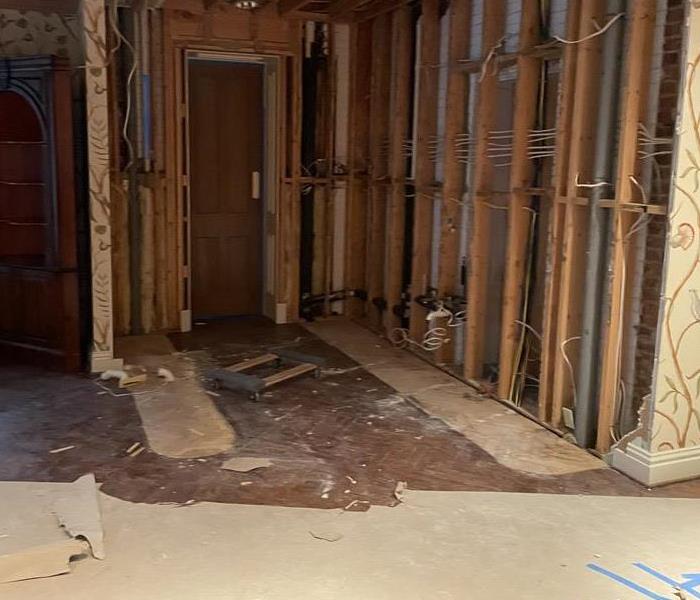 Call SERVPRO for your fire restoration emergency.
Call SERVPRO for your fire restoration emergency.
Home fires can be devastating, causing property damage, injuries, and even loss of life. Understanding the leading causes of home fires is crucial for prevention and safety. In this blog, we will explore common causes of home fires, offering practical tips to keep your home and loved ones safe.
Cooking Accidents
Unattended cooking is one of the primary causes of home fires. Grease fires, overheating, and flammable materials near stovetops can quickly escalate. Always stay in the kitchen while cooking and use timers as reminders. Keep combustible items away from heat sources and have a working fire extinguisher within reach.
Heating System Mishaps
Heating equipment, such as furnaces, portable heaters, or fireplaces, can lead to home fires if not handled properly. Ensure that heaters are kept away from flammable materials and have proper clearance. Follow manufacturer's instructions for maintenance and regular inspections. Install carbon monoxide detectors and tested smoke alarms to provide early warnings.
Electrical Malfunctions
Electrical issues can be dangerous and result in home fires. Overloaded outlets, frayed wires, faulty appliances, or outdated wiring are common causes. Have a professional electrician inspect your electrical system regularly. Avoid using extension cords as a permanent solution and unplug appliances when not in use. Never attempt DIY electrical repairs unless you are a qualified professional.
Smoking Materials
Smoking-related incidents are a significant cause of home fires, especially when cigarettes are not properly extinguished or are smoked in bed. If you smoke, do so outside the home and use designated ashtrays. Ensure cigarettes are completely extinguished before discarding them. Avoid smoking when tired or under the influence of medication or alcohol.
Arson and Fireworks
Although less common, arson and fireworks can still lead to devastating home fires. Take precautions to secure your property and report any suspicious activity to authorities. Exercise caution and follow local regulations when using fireworks, ensuring a safe distance from buildings and flammable materials.
Awareness of the leading causes of home fires is essential for prevention and safety. By practicing vigilance in the kitchen, maintaining heating systems, addressing electrical concerns, and adopting safe smoking habits, homeowners can significantly reduce the risk of a fire-related incident. Stay informed, be prepared, and prioritize fire prevention measures to safeguard your home and loved ones. Give SERVPRO® of Clayton/ Ladue a call for your fire restoration emergency assistance. We are here to help when disaster strikes.
What Kind of Smoke Detector Should I Buy? Your Guide to Choosing the Right Type for Your Home
8/3/2023 (Permalink)
Smoke detectors are an essential safety tool in any home, providing an early warning system in the event of a fire. However, with different types of smoke detectors available on the market, it can be challenging to determine which one to choose. In this blog post, we will provide you with a guide on what kind of smoke detector to buy by explaining the different types of smoke detectors and their features.
Ionization Smoke Detector
Ionization smoke detectors are the most common type and function by using a small amount of radioactive material to ionize the air between two electrically charged plates. When smoke enters the chamber, it disrupts the current and sets off the alarm. These detectors are best suited for detecting fast-burning fires that produce small smoke particles.
Photoelectric Smoke Detectors
Photoelectric smoke detectors use a light source and a photosensitive sensor to detect smoke. When smoke enters the chamber, it scatters the light, causing it to strike the sensor and set off the alarm. These detectors are best suited for detecting smoldering fires that produce large smoke particles.
Dual-Sensor and Smart Smoke Detectors
Dual-sensor smoke detectors combine both ionization and photoelectric technologies for better detection of both fast-burning and smoldering fires.
Smart smoke detectors are connected to your home's Wi-Fi network and can send alerts to your phone when smoke is detected, even when you are away from home. Some smart smoke detectors can also sense carbon monoxide and have other advanced features, such as self-testing and voice alerts.
Combination Smoke and Carbon Monoxide Detectors
Combination smoke and carbon monoxide detectors not only detect smoke but also detect carbon monoxide, which is an odorless, colorless gas that can be deadly. These detectors are ideal for homes with gas appliances or attached garages.
When selecting a smoke detector, it is important to consider the size of your home, the number of rooms, and the location of potential fire hazards, such as the kitchen or fireplace. It is recommended to install a smoke detector on every level of your home, including inside and outside bedrooms, and to connect alarms for added safety. Consider purchasing a combination smoke and carbon monoxide detector if you have gas appliances or an attached garage.
In addition to selecting the right type of smoke detector, ensure that the detector is certified by a reputable testing agency, such as Underwriters Laboratories (UL). Follow the manufacturer's instructions for installation and regularly test the detector to ensure it is in good working condition. Replace batteries at least once a year or when the detector begins to chirp, indicating a low battery.
Investing in the right smoke detector is critical to ensure the safety of your home and loved ones. Be sure to evaluate your needs, consider the different types of smoke detectors available, and select the appropriate smoke detector for your specific situation. Don't hesitate to seek advice from a professional if you have any questions or concerns. By having the right smoke detector on hand, you can protect yourself and those around you year-round.
Know Your Fire Extinguishers: A Guide to Different Types of Fire Extinguishers
5/1/2023 (Permalink)
Fires can occur at any time and in any place, and it's essential to have the right fire extinguisher on hand to suppress the flames. There are different types of fire extinguishers designed to tackle specific classes of fires. In this article, we'll discuss the different kinds of fire extinguishers and which ones are best suited for different types of fires.
Class A Fire Extinguishers
Class A fire extinguishers are designed to put out fires that involve ordinary combustibles such as wood, paper, and cloth. These types of fires are common in homes and offices. Class A fire extinguishers contain water or a foam solution to smother the flames and cool the burning material.
Class B Fire Extinguishers
Class B fire extinguishers are designed to put out fires that involve flammable liquids such as gasoline, oil, and grease. These types of fires are common in garages, kitchens, and workshops. Class B fire extinguishers contain a dry chemical or foam solution to smother the flames and prevent re-ignition.
Class C Fire Extinguishers
Class C fire extinguishers are designed to put out fires that involve electrical equipment such as computers, appliances, and wiring. These types of fires are common in offices and industrial settings. Class C fire extinguishers contain a dry chemical or carbon dioxide to smother the flames and prevent electrical shock.
Class D Fire Extinguishers
Class D fire extinguishers are designed to put out fires that involve flammable metals such as magnesium, sodium, and potassium. These types of fires are uncommon in homes and offices but are common in industrial settings. Class D fire extinguishers contain a dry powder to smother the flames and prevent re-ignition.
Class K Fire Extinguishers
Class K fire extinguishers are designed to put out fires that involve cooking oils and fats. These types of fires are common in kitchens and restaurants. Class K fire extinguishers contain a special wet chemical solution that reacts with the oil or fat to create a barrier and prevent re-ignition.
Water mist fire extinguishers are designed to put out fires that involve combustible materials such as wood, paper, and cloth. These types of fire extinguishers use a fine mist of water to smother the flames and cool the burning material. Water mist fire extinguishers are safe to use on electrical fires and are ideal for homes and offices
Knowing the right type of fire extinguisher to use is important in keeping your home or business safe incase of a fire.
Spring Safety Tips
2/5/2023 (Permalink)
Spring is finally here, and it’s time to get out of the house and enjoy the great outdoors. Spring can also be a dangerous season for accidents involving fire. Here are some tips to help you stay safe this spring. Take safety precautions when working indoors and out.
Ladder Safety
Practice outdoor safety when working outside. Use a ladder or other safe equipment safely to prevent fall and slip hazards. Wear protective clothing and footwear when working outdoors. Do not use power tools in wet weather. Don't work alone, especially if you have a disability or health condition that could impair your ability to get away in an emergency.
Practice maintenance of your lawn mower
Always make sure that your lawnmower is in good working order before use. It's a good idea to mow the lawn when the grass is dry, and always wear safety goggles. Don't mow wet grass, and also avoid operating your machine during windy conditions.
Check outdoor grills frequently
Check outdoor grills and flammable liquids often for leaks. Keep grills away from all open flame and never leave a grill unattended. If you're going to be gone for more than an hour and can't put it on "low" or "warm," consider bringing it in and storing it in an area that's cool and dry.
Never store flammable liquids near the grill where flames could potentially be present and cause a fire. Keep combustible items away from all heat sources, including appliances like toasters and space heaters. Don't leave cooking food unattended.
Gasoline and Propane
Another important safety tip is to ensure that you keep gas and propane in a safe place. Never store these flammable liquids near any appliance that uses fire, such as the water heater or furnace. Also make sure to keep it out of reach of children and pets.
Disposing of Hot Ashes
Keep in mind when disposing of hot ashes, to not just dump them in a plastic garbage can. They can stay hot for days and potentially cause materials in the trash to catch fire. Put the hot ashes in a metal container outside, at least three feet away from the house to be safe. Make sure the metal container is tightly covered and the lid doesn't have any openings.
Spring is a great time to get outside and enjoy the weather! It is also important to make sure you’re taking all the necessary precautions to stay safe! Whether you’re working on your lawn or cooking dinner, always be aware of how flammable materials that are stored or used near heat sources. Always remember that even something as simple as ashes can pose a threat when they are not disposed of properly.
3 Things to Consider Before Installing a Fire Sprinkler System
1/10/2023 (Permalink)
When you're building a home, there are many things to consider. You need to think about how the design will function and look, as well as which materials will be used. Having a fire sprinkler system in your home can be beneficial for several reasons. It can help protect against fires, protect your property from damage during these emergencies, and even help reduce the insurance premiums that come with owning certain types of homes. While installing one may seem overwhelming at first glance, there are three things that you should take into consideration before making any final decisions about whether or not this type of protection is right for your home.
The Environment:
Before you begin the installation process, you should make sure that your building is suitable for a fire sprinkler system. While most buildings are, there are some that are not. For example, if your building was built before 1994 or has been modified since then, it might not be able to support a traditional wet pipe system. In these cases, other types of systems will be needed — and some codes may require them by law anyway!
The same goes if your building is made from combustible materials such as wood or paper (though these can both be covered up with cladding). Additionally, large open spaces like warehouses should have sprinklers installed on their ceilings so they don't waste water by flooding entire rooms when they're activated.
The Applicable Building Standards:
When it comes to building codes, the applicable standard is whichever one you choose. The building code is the minimum fire protection standard your city or county requires, while the fire code is the maximum standard for which you can install a system. If your city or county has adopted either of these standards, then it’s up to you whether you want to install a system that meets their requirements or exceeds them.
If you’re looking for guidance on what type of sprinkler system works best in different buildings and spaces — or if this is just an overview on what options are available — we have some helpful resources.
The Cost:
You should also consider the cost of a fire sprinkler system. The cost of a fire sprinkler system varies depending on the size of your building, its location, and whether you are installing a new or retrofit system.
Insurance premium savings can help offset some of these costs. Insurance companies typically offer lower premiums for buildings with automatic sprinkler systems than for those without them.
The type of system you choose will also affect how much you spend on installation:
- Dry pipe systems are less expensive than wet pipe systems because they do not require water pipes to be connected to each sprinkler head.
- High-rise buildings need larger diameter pipes that are more expensive and difficult to install than low-rise one-story buildings.
You can install an efficient and effective fire sprinkler system in your home with the right information.
If you're worried about the safety of your home, then a fire sprinkler system is something to consider. It can help protect your family and belongings from fires in many ways.
For starters, installing one of these systems provides peace of mind by protecting the structure of your home. When a fire breaks out in a building without sprinklers, it can quickly become an unstoppable blaze that spreads throughout the entire property and leads to extensive damage — in some cases, even loss of life. But if there's a sprinkler system installed throughout the building? The water pressure can put out small fires before they start messing with electrical wires or cause structural instability in walls or ceilings. And if those early flames do turn into something bigger? The water spray will keep spreading them out instead of giving them an opportunity to grow larger and more important areas — like bedrooms or offices where valuable items are stored—are spared from damage as well as possible.
Fire sprinkler systems can be a great investment for your Glendale, MO home. They are an effective way to protect your family and belongings in case of a fire. But it’s not something you should rush into — make sure you do your research first.
What To Know About Professional Fire Restoration
9/1/2022 (Permalink)
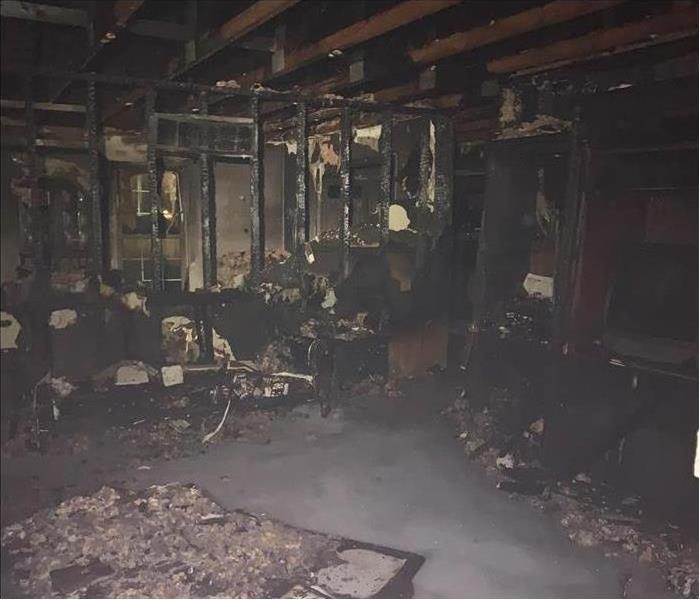 Residential fire damage in University City, MO.
Residential fire damage in University City, MO.
What Professionals Can Help You Do After a Fire
In case of a house fire, you do not want to handle the restoration alone. A professional service is more equipped to handle the smoke cleaning and restoration process. If you are on the fence, however, here is what professionals can help you to do after a fire.
1. Inspect Building
A professional should always inspect a building for fire and smoke damage. They can give you the best estimate on what to do to repair your home or business. In addition, professionals give you more peace of mind that they will perform every step properly.
2. Remove Items
Item removal is one of the most important steps of the process. Fire can damage items and furniture beyond repair. Your contractors are usually able to go through your items with you and assess soot damage. They help you decide what to clean and what to throw out. The same goes for key components of your home, such as walls and flooring.
3. Repair Structure
The final step is to start the restoration of the building. This usually entails the cleaning of all soot. The professionals may use a variety of air filters or fans to clean the air and help with the circulation of airflow. This helps remove some of the smoke odor. However, for contractors to get rid of the smell entirely, they must take care of the source. Smoke cleaning often involves the repair of anything that suffered smoke damage. After, restoration on the building can finally begin. Not only can workers finish the cleanup, but they can also begin to repair the structure.
After a house fire in University City, MO there is already a lot of stress on you and your loved ones. To have a professional at your side to help you through the restoration process is invaluable. It takes away some of the pressure when cleaning up smoke damage.
How To Use a Fire Extinguisher
7/11/2022 (Permalink)
It is important that all homes in Glendale, MO have at least one fire extinguisher. Since a kitchen fire is one of the biggest concerns in a home, having one in this room is a good idea. The sooner you can get a fire out, the more fire damage you might be able to prevent. It is important that you know how to use one so that you have the best chance of preventing a small fire from spreading.
Choosing a Fire Extinguisher
Before knowing how to use a fire extinguisher, you want to ensure that you have the right one for your home. You will find A, B, and C classifications for these, and you want one that is classified for all three so that it is able to fight against flammable liquid, combustibles, and electrical fires. It is recommended that you have an extinguisher on every floor of your home. You should also test the weight to ensure that you are able to easily maneuver it.
Proper Use of a Fire Extinguisher
You should use the PASS method to properly operate a fire extinguisher. This includes the following steps:
Pull the pin on the extinguisher, and hold it in a position so that the nozzle is pointed away from your body before you release the locking mechanism.
Aim low, and make sure that it is pointed at the fire’s base.
Squeeze the lever on the extinguisher evenly and slowly.
Sweep the nozzle in a side-to-side motion.
After using an extinguisher, you should still call the fire department to come and inspect the area. The firefighters can ensure that the fire is fully out and that your home is safe.
Make sure that you get a fire extinguisher that is the proper size. Then, take note of the usage instructions. For further information, the local fire department in Glendale, MO can often make solid recommendations for your home.
How To Make a Fire Claim
6/15/2022 (Permalink)
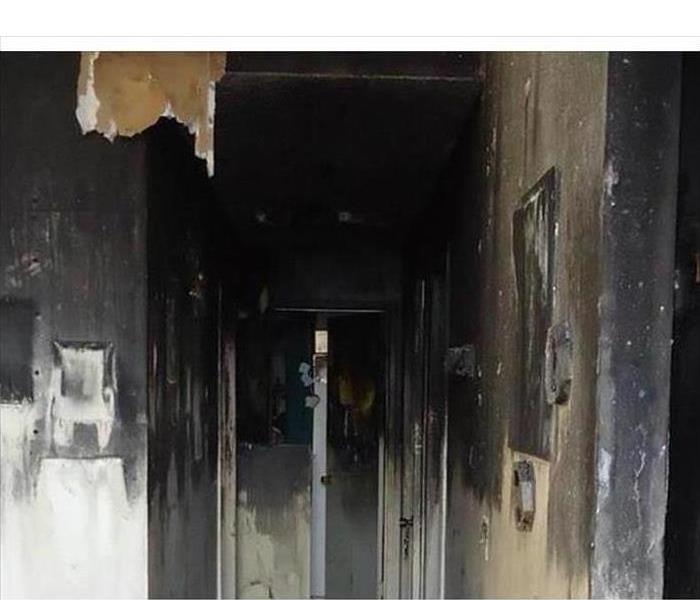 Fire damage in Brentwood, MO.
Fire damage in Brentwood, MO.
Steps To File a Fire Claim
Fires can start from any number of sources, such as household appliances, electrical systems, candles, or lightning. Having a plan in place helps you manage the fire restoration process effectively.
In the aftermath of a fire, follow these steps to file a claim with your insurance company.
1. Contact Your Insurance Agent ASAP
The owner of a fire policy in Brentwood, MO, is expected to file the claim as soon as possible. You can call your insurance agent to get the process started.
2. Understand Your Fire Insurance Policy
To ensure that the insurance company is holding up its end of the bargain, it is important for you to read the details of your policy. For example, different policies may have different coverage amounts for smoke cleaning. If you know exactly what you are entitled to as a policyholder, you will be able to proceed with confidence.
3. Gather Important Information
Once you file the claim, the insurance company will ask you to complete a "proof of loss" document. This is where you list all of the lost items and their estimated value. Submitting this form quickly and accurately is crucial for expediting the overall claims process and making sure that the insurance company prioritizes your case.
4. Keep Detailed Records
Remember that it is important to document everything. Take pictures of all instances of damage, and don't touch the damage. Keep records of every correspondence you have with the insurance company and the fire restoration company.
5. Keep the Claim Open As Long As Needed
As the policyholder, you get to decide when to close the claim. It is common to find additional damage in the ensuing weeks after a fire. If further fire restoration services are required, it is important to keep the claim open.
If you know what to expect in the aftermath of a fire, you will be able to tackle the claims process effectively and allow your home to recover.
Fire Damage Preparation Tips
1/17/2022 (Permalink)
Fire Preparation
As hard as it can be to think about, a fire could occur at your place of business. While a fire and its related damage are very real risks that you need to consider, there are things you can do to prepare for a possible future fire - and sleep a little easier at night. Here are five steps you can take to help you with fire preparation.
1. Understand your insurance plan. Make sure that you understand your commercial insurance coverage, claim requirements and any special conditions that apply to fire damage. If you don’t like one of the provisions of your policy, talk to your agent about adding or removing coverage.
2. Estimate replacement and repair costs. This is an important step to take to understand how much focus needs to be put on fire preparedness within your company. Making estimates will also help you identify your most vulnerable equipment.
3. Protect your workers. Make sure that your entire team is trained on fire preparation. Create an emergency escape plan that everyone can learn and remember so that they can exit the building as quickly and safely as possible during a fire.
4. Safeguard your business. Your business needs an emergency plan of sorts, too. Create a plan of recovery so you know what to do to reopen after a fire. This should include planning on the Ladue, MO, commercial fire damage service you will use if damage occurs.
5. Back up important files. Business records, repair service provider lists, financial spreadsheets and inventories are some examples of documents that should be preserved to the best of your ability as part of your disaster preparation plan. You can store these at an offsite location, but you should also consider utilizing electronic cloud services to keep online copies of your most important files.
Fire preparation is important not only for your company and finances but also for the well-being of you and your entire staff. Put these steps into action for a better defense against building fires.





 24/7 Emergency Service
24/7 Emergency Service




